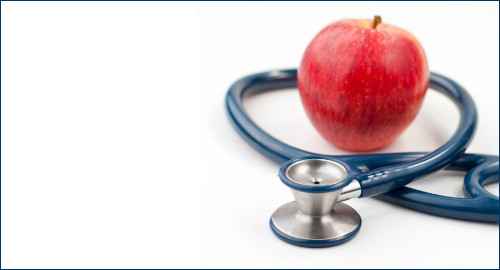Five tips to manage high blood pressure
May is National High Blood Pressure Education Month, an observance to highlight the importance of blood pressure control, stroke prevention and improving heart health for everyone. Our experts want to take this opportunity to examine this issue that affects nearly half of U.S. adults.
High blood pressure can often go unnoticed because it does not always cause symptoms, but it’s important to treat your high blood pressure. If your blood pressure stays high for a long period of time, it can damage your heart and its arteries, and put you at a risk for health problems. Let’s discuss some tips to help keep your blood pressure at an appropriate level.
What does it mean to have high blood pressure?
Blood pressure is simply the force of blood pushing against the walls of your arteries as the heart pumps blood. High blood pressure, or hypertension, means there is too much force — an even more significant health problem for older adults. According to the National Institute on Aging, this is because our vascular system changes as we get older; our arteries get stiffer, causing blood pressure to go up.
Blood pressure is reported by two numbers. According to the American Heart Association (AHA), the first number is the systolic blood pressure which indicates how much pressure your blood is exerting against your artery walls when your heart is beating. The second number is diastolic blood pressure which indicates how much pressure your blood is exerting against your artery walls when your heart is resting between beats.
Normal blood pressure is a systolic number of 120 or less, and a diastolic number of 80. If your blood pressure is 130/80 or greater, your doctor will discuss various treatments to lower it. The tips below will help you make the most out of your treatment!
Tip #1: Eat healthy
One proven way to manage blood pressure is with diet. Dietary Approaches to Stop Hypertension (DASH) is an eating plan designed to promote heart health. It doesn’t require any special foods, but rather encourages eating vegetables, fruits, whole grains, low fat dairy products, fish, poultry, beans, nuts and vegetable oils, and limiting sugars.
Be mindful of sodium in your food when eating to manage high blood pressure. You can learn how much sodium is in your food by looking at nutrition labels. (Remember, it’s not only salty-tasting foods that contain large amounts of sodium). Avoid foods that have 20 percent or more of your daily recommended amount of sodium. The AHA recommends taking in less than 2,500 milligrams (mg) of sodium each day for those without elevated blood pressure. For individuals with high blood pressure, diabetes, kidney disease and for African Americans (who have increased risks with too much sodium), the recommendation is a limit of 1,500 milligrams daily. That’s less than the equivalent of a teaspoon of table salt for an entire day!
Aspire Health offers resources to support you as you begin to follow the DASH diet above. Our members can sign up for health coaching at no cost to you! Our health coaches are professionals who offer personalized one-on-one telephone support to help you develop behavior change strategies and self-management action plans, with follow-up based on your risk level. Looking for support to reach a health goal? Call one of our local, dedicated health coaches at (831) 644-7490.
Montage Health and Salinas Valley Memorial Health System also offer health and wellness classes on a number of topics, including nutrition management, heart health and more.
Tip #2: Exercise regularly
Regular exercise can help manage your blood pressure. According to the Centers for Disease Control (CDC), 30 minutes of physical activity 5 days a week can help keep your blood pressure in a healthy range. A brisk walk or a bike ride can go a long way to managing hypertension. You should also take 5 or 10-minute stretch breaks throughout the day.
Talk to your doctor before engaging in a new exercise routine. Once cleared for regular activity ask yourself: 1) what sounds fun to me? It could be a walk, dancing, gardening—as long as you enjoy it. 2) Do you want to move in a group or on your own? Explore local group classes in your area such as the Montage Wellness Center which offer a special membership to Aspire MA members.
The Blue Zones Project® of Monterey County offers some great local opportunities to help you incorporate more walking into your day! Consider registering for a local Moai® (pronounced “Mo Eye”) Walking Group. These are groups of 5-8 people that meet at least once a week to walk throughout the community. Check out their schedule for upcoming events and read more about how Moai® Walking Groups can support your physical and emotional health.
If you live in Salinas Valley, check out Salinas Valley Memorial Hospital System’s monthly “Walk With A Doc” events. Participants can walk at their pace, with friends, or with the group while engaging in conversations about diabetes management, chronic disease, joint health, and more with local SVMHS physicians. Visit their website to learn more about the Walk With A Doc program.
Tip #3: Make positive lifestyle choices
In addition to diet and exercise, there are several other lifestyle changes you can make to keep your blood pressure at the appropriate level.
- First, stop smoking and avoid secondhand smoke. Quitting smoking will lower your risk of heart disease considerably. Talk to your doctor if you need help quitting.
- Second, limit how much alcohol you drink. Drinking too much alcohol can raise your blood pressure. Stick to recommended amounts (no more that one daily drink for women, or two for men).
- Third, make sure you are getting enough sleep. Sleep is important to all areas of your health, but can be especially important for heart and blood vessel health. The CDC’s sleep and sleep disorders website has some valuable resources to help you get better sleep.
Tip #4: Make regular appointments with your doctor
One reason to visit your doctor regularly is to check your blood pressure. If your blood pressure measures as high, you will be started on a treatment plan, which might include medication if lifestyle changes aren’t enough. Remember, always follow your doctor’s instructions when taking medications. If you don’t understand any of the instructions, ask questions — and never stop taking medications without talking to your doctor first.
Tip #5: Manage your diabetes
Most people with diabetes also have high blood pressure. Over 50 percent of adults in Monterey County have prediabetes or type 2 diabetes. Check out our Diabetes Prevention Program to learn more about our dedicated team of healthcare and wellness professionals who offer personalized programs that help adults and children understand the disease, learn about prevention and treatments, and make healthy lifestyle choices.
Treatments to manage your blood glucose can also help lower blood pressure. If you have diabetes, remember that blood pressure is one of the ABCs of diabetes that the CDC recommends working on with your doctor.
- A1c: Set a goal for your blood sugar (A1c) level. For most people, this level is 7%, but your doctor may recommend a different goal for you.
- Blood pressure: As discussed, high blood pressure can increase your risk of heart disease. Keep your blood pressure at 120/80, or the number recommended by your doctor.
- Cholesterol: There are good and bad types of cholesterol! Ask your doctor what your levels should be.
We hope that these tips will be helpful in managing your blood pressure! If you have any questions, the Aspire Health Plan is always here to help. Reach out to us today at (855) 570-1600. For all matters related to your health, remember to consult your healthcare provider.
H8764_MKT_BlogBloodPressureTips_0522_C










